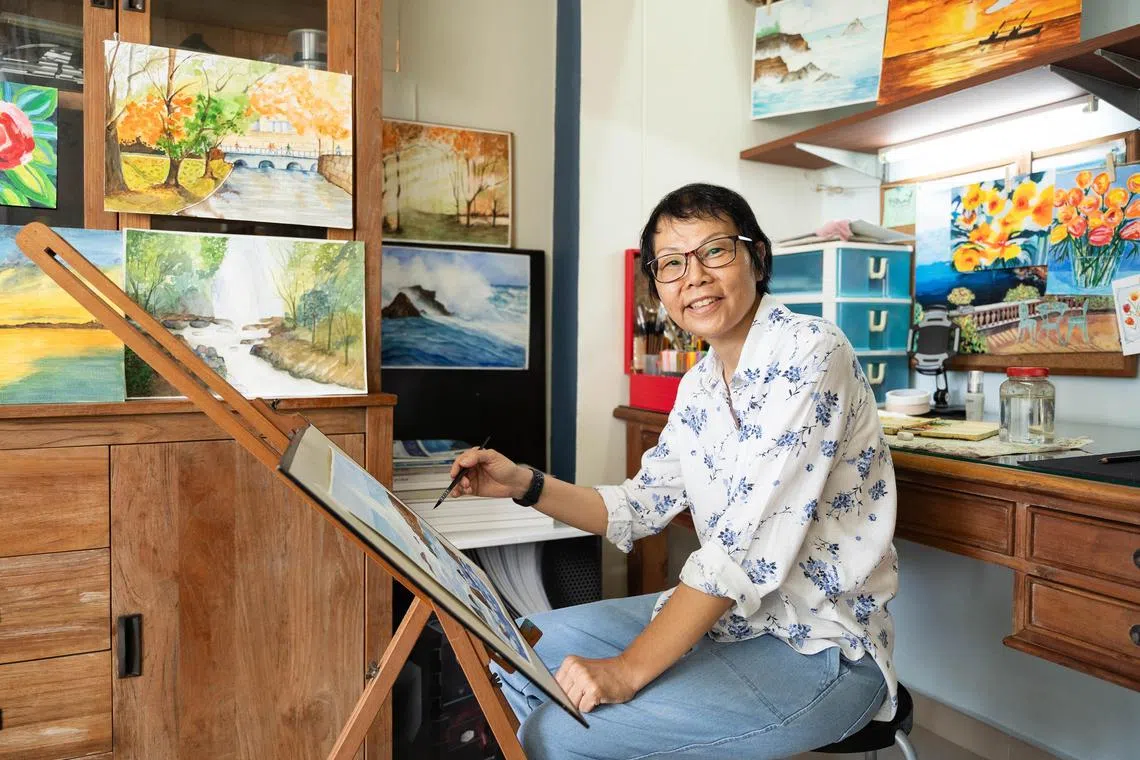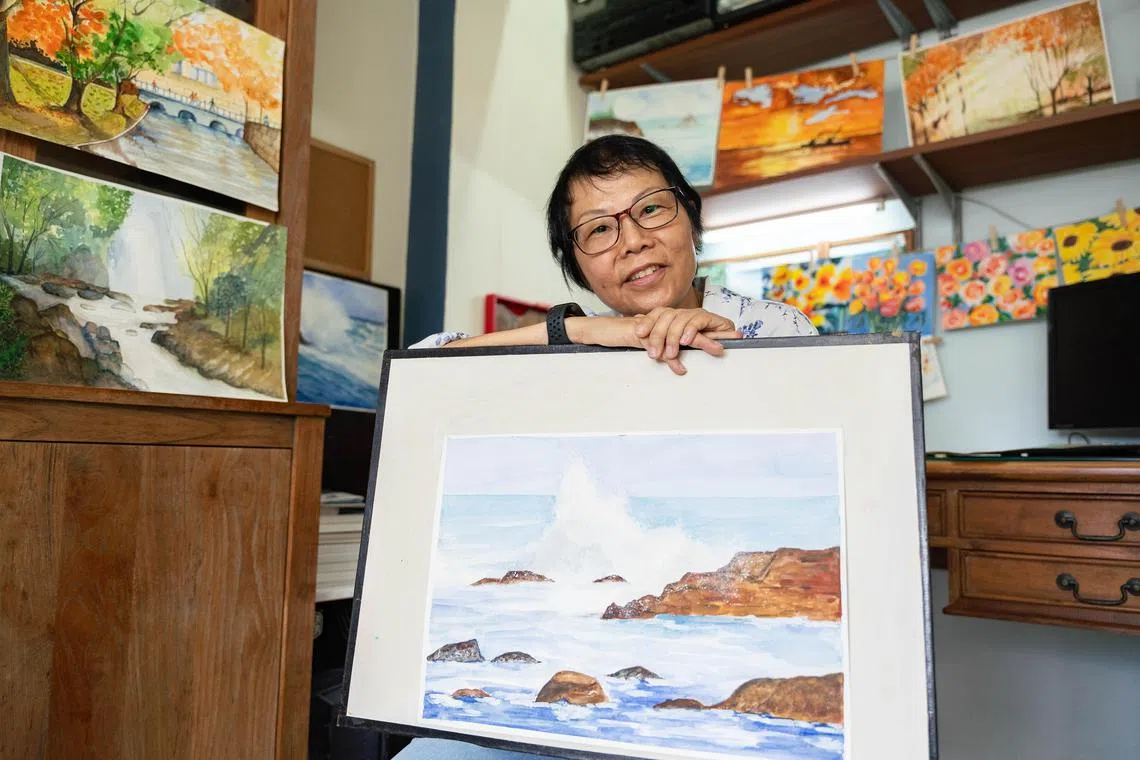Cell therapy: Using living cells to cure disease
Sign up now: Get ST's newsletters delivered to your inbox

Madam Fung Mei Fong is now in remission after receiving experimental chimeric antigen receptor T-cell therapy.
ST PHOTO: BRIAN TEO
Follow topic:
SINGAPORE – Diagnosed with large diffuse B-cell lymphoma in May 2021, Madam Fung Mei Fong went through a series of conventional treatments that were unsuccessful, leaving her close to giving up.
The average lifespan of patients with large diffuse B-cell lymphoma, a type of cancer that affects the body’s lymphatic system, is less than one year if left untreated.
After her first chemotherapy treatment, the 62-year-old lost weight, and for several months had to use a wheelchair as a result of foot drop, a complication which affects the nerves in the feet.
Following her first round of chemotherapy, a scan showed that the cancer had spread to the rest of her body. A second round of chemotherapy also failed.
A third therapy called R-Pola Len – for the drugs polatuzumab vedotin, rituximab and lenalidomide – was among the few options left. It caused Madam Fung to lose her appetite. But the cancer continued to spread.
A stem cell transplant to replenish the blood stem cells in her bone marrow, allowing them to produce healthy new blood cells, was ruled out for the grandmother of two as chemotherapy had depleted her white blood cells, making her unsuitable for the procedure.
Throughout the year-long process, Madam Fung’s 63-year-old husband was her rock, doing the chores and helping her go to the toilet when she was too weak to go herself. She also turned to painting and drawing to give herself relief.
It was then that Madam Fung was introduced by her doctors to experimental CAR (chimeric antigen receptor) T-cell therapy, where T-cells – a type of white blood cells that help fight infections – are genetically altered in a lab to kill cancer cells and infused back into the patient.
Chimeric antigen receptors are artificial proteins which can bind to specific proteins on the cancer cells, allowing the immune cells to track down cancer cells.
She received the infusion in July 2022, and remained in the hospital for almost a month after the infusion for monitoring. All her food had to be fully cooked to protect her immune system from bacteria and other harmful organisms.
Speaking to The Straits Times a year after the process, Madam Fung said she is now in remission, with tests showing no sign of lymphoma.
While she was initially scared about having to go through such a complex treatment, Madam Fung said doctors helped assure her, and she saw the therapy as her “last chance”. “I’m very happy to have gone through (CAR T-cell therapy),” she said.

Madam Fung turned to painting and drawing to give herself relief while being treated for lymphoma.
ST PHOTO: BRIAN TEO
Madam Fung is one of about 100 people here who receive cell and gene therapy treatments each year, thanks to advances in research which have opened up new ways to treat cancer with cells, dubbed living drugs.
A form of precision medicine that is tailored to meet the specific needs of patients, cell therapy is a promising new area. Research has shown that CAR T-cell therapy, for example, allows cancer patients to recover more quickly without the need for aggressive chemotherapy, and achieve longer-lasting remissions.
In Singapore, where an estimated one in four people is expected to get cancer by the age of 75, cell and gene therapies offer hope as possible treatment options, starting with certain forms of blood cancer.
What is cell therapy?
Cell therapy refers to the harnessing of living cells to treat diseases such as cancer and autoimmune disorders, said Associate Professor Danny Soon, interim executive director of the Advanced Cell Therapy and Research Institute, Singapore (Actris).
Actris is a programme under the Consortium for Clinical Research and Innovation, Singapore (Cris), which brings together several research programmes of the Ministry of Health.
In CAR T-cell therapy, blood is drawn from the body, and passed through a machine which separates the T-cells and returns the remaining blood to the body.
CARs are added to the T-cells, reprogramming and super-charging them to find and kill cancer cells.
“This can be a lifeline to patients who have failed conventional treatments for aggressive leukaemia and lymphoma,” said Prof Soon, who is also chief executive of Cris.
Besides the treatment of such cancers, potential uses for cell therapies include the treatment of degenerative conditions like rheumatoid arthritis, said Actris chief medical officer Francesca Lim.
“There is work under way for the treatment of solid organ tumours, such as nasopharyngeal and liver cancers,” she added.
In Singapore, CAR T-cell therapy is available to some patients up to the age of 25 who have relapsed or not responded to therapy for acute lymphoblastic leukaemia, as well as some adults with certain types of lymphoma who have relapsed or not responded to initial treatment.
As with all medical treatments, there are potential side effects, though these can be managed, said Dr Lim.
They include severe responses such as cytokine release syndromes, where the immune system produces an overly aggressive response to immunotherapy drugs.
More cell therapy facilities in Singapore
Market research firm Grand View Research said the global cell therapy market is expected to reach US$15.89 billion (S$21.8 billion) by 2028, from US$5.46 billion currently.
With the growing popularity of cell therapy and the high level of biomedical proficiency in Singapore, several cell therapy manufacturing facilities have opened their doors here in 2023.
These include a 1,500 sq m facility officially opened by Singapore-based Biosyngen in June to manufacture immunotherapy drugs.
In July, local start-up SCG Cell Therapy – which in April was reported to have raised US$8.1 million in a funding round – opened a 850 sq m manufacturing and research and development facility in Depot Road.
SCG Cell Therapy developed SCG101, a T-cell therapy product for treating hepatitis B-associated liver cancer, which is currently in clinical trials in Singapore, China and the United States.
The firm’s new facility employs automated cell therapy manufacturing technologies, which reduce manpower needs and can significantly reduce the cost of treatment.
In August, Actris launched a 2,000 sq m facility in the National Cancer Centre Singapore’s building,
Hospitals and research institutions, among others, will be able to use the facility to support their work in areas such as cell selection and genetic modification for both research and clinical work.
Actris will also work with partners to enhance efficiency in the manufacturing process, which could lower costs, said Prof Soon.
Calling it a game changer for Singapore’s cell therapy ecosystem, Actris chairman and Singapore Medical Council president Chee Yam Cheng said at the launch of the facility that manufacturing high-quality cell therapies locally will allow patients to gain quicker access to life-saving therapy.
However, it has not all been smooth sailing for the sector here.
In June, Tessa Therapeutics – a CAR T-cell front runner in Singapore and the darling of the biotech scene which had received US$397.8 million in equity funding since it was founded in 2012 – announced that it was ceasing operations after failing to secure more funding for its cancer treatment cell therapies.
Associate Professor Jeremy Lim, who is from the National University of Singapore’s Saw Swee Hock School of Public Health, said entering the biotech sector is expensive and fraught with risk.
Making treatments more affordable
As many cell and gene therapies are still experimental in nature, they tend to be very costly, said Actris’ Dr Lim, pointing to the specialised infrastructure and advanced equipment required.
Kymriah CAR T-cell therapy – which is approved here for the treatment of B-cell acute lymphoblastic leukaemia and diffuse large B-cell lymphoma under specific circumstances – is reported to cost some US$475,000.
The treatment is not on the Health Ministry’s approved Cancer Drug List.
Many here receiving CAR T-cell therapy are part of clinical trials, where the cost of treatment is paid for. They include Madam Fung, whose treatment was manufactured at a Health Sciences Authority facility.
Prof Soon noted that there are ongoing efforts worldwide to make cell therapies safer and more affordable.
In a study published in the journal Nature Biomedical Engineering in 2022, researchers from the University of Pennsylvania were able to generate functional CAR T-cells in just 24 hours, compared with nine to 14 days usually. This could cut costs by reducing the time, materials, and labour required to generate such cells.
Health Minister Ong Ye Kung has also said that an appropriate financing framework is needed to prevent a rift between those who can afford such treatments and those who cannot.
As cell and gene therapies are relatively infrequent in deployment and costly, the solution is likely to lie in strengthening national healthcare insurance, he said.
NUS’ Prof Lim said that while insurance can be expanded to cover such costs in the short term, in the longer term, other financing models will need to be considered as the use of cell and gene therapies becomes more common.
He noted, however, that as the technology becomes more widespread, it is likely to become more affordable.
For Madam Fung, being in the clinical trial not only meant that she was given a chance to beat her cancer, but also allowed her to contribute to medical research, so that others may benefit some day from cell therapy.
“With today’s advanced medical science, we do have hope, provided we don’t give up,” she said.

